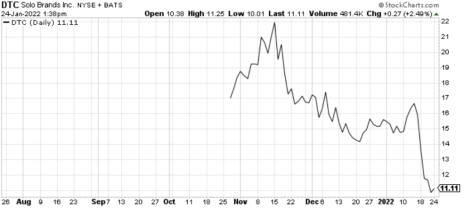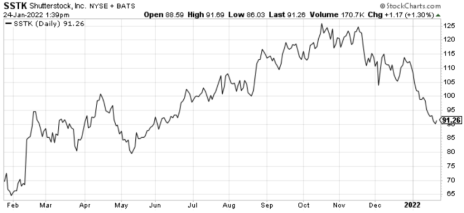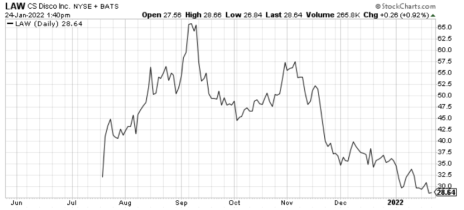Well, we’re officially in a bear market in growth stocks. And it’s been particularly tough going in the super-fast growing small-cap stock arena. The S&P 600 Small Cap Index is 15% off its high while many individual names are down -30% to -60% from 2021 levels.
The rest of the market increasingly looks like garbage too.
The S&P 500 is -10% off the peak, the Nasdaq is -18% off the peak and the Dow is -7% off the peak.
Moreover, trading patterns have completely disconnected from company-specific factors.
[text_ad]
It’s all about Omicron, a potential rapid increase in interest rates, still too-high inflation, and the end of life support at the hands of doctors at the Fed, Treasury and U.S. government. Those docs are now saying it’s now up to corporations and consumers to keep the economy’s heart beating.
On the other hand, EVERYTHING looks grey when storm clouds are overhead. At these times it’s easy to play the Eeyore card and think, as the world’s most pessimistic grey donkey said, “The sky has finally fallen. Always knew it would.”
But that’s a dismal way to go through life. And when it comes to the market there is always a silver lining somewhere.
Consider the case for small-cap stocks right now.
Data from Bank of America shows small caps are cheap versus history, trading with a forward P/E of 14.7.
They trade at a 27% discount to large-cap stocks. That’s below the COVID crash and Great Financial Crisis lows. And it makes small caps the cheapest since 2000!
Many of the most beaten-down small-cap stocks will also be the ones with the most upside when things turn around.
The one factor that has overwhelmingly led to upside performance coming out of corrections – especially with smaller companies – is revenue growth and revenue beats.
If you’re interested in building a small-cap shopping list, that’s the factor you should focus on. Potential for EPS growth and/or near-term profitability should be second on the list.
With Q4 earnings season ramping up and a recent acceleration in stock market declines, I think we’re at or near a point where investors will begin to hunt for deals and re-focus on these types of company-specific factors.
Here are three beaten-down small-cap stocks that would be near the top of my shopping list, for very different reasons.
Beaten-Down Small-Cap Stock #1: Millennial Consumer Play
Solo Brands (DTC) is a direct-to-consumer company that sells outdoor-oriented products under a number of different and well-recognized brands. It has a market cap of $1.0 billion.
The best-known brand, Solo Stove, drives roughly 65% of revenue. These smokeless, stainless steel fire pits, camp stoves and grills have been popping up all over the country and the company continues to roll out accessories that increase the functionality of the core product. This is the product the company was formed around in 2011.
Solo Brands also owns Chubbies, a manufacturer of shorts, swim trunks, shirts, hoodies, jackets and other casual and athletic apparel. Chubbies generates around 20% of revenue and was acquired in 2021.
Solo Brands also owns Oru Kayaks (acquired May, 2021), which makes a line of foldable and packable origami kayaks (6% of revenue) and ISLE (acquired August 2021), which makes a line of inflatable paddleboards (10% of revenue).
Solo Brands’ marketing tilt (and popularity) targets the millennial crowd, which is beginning to make up a larger portion of the homeowner and consumer spending pie.
My biggest concern with this business is that it becomes another flash-in-the-pan growth story but demand cools if consumer enthusiasm for “the next cool thing” fades. Also, given that many of Solo Brands’ products are somewhat higher ticket items (with the exception of Chubbies) and last several years, there isn’t going to be a big replacement cycle for things like stoves and kayaks.
However, the company’s products are very functional and definitely create a buzz. It continues to introduce both new and accessory products (such as cooktops, heat deflectors, shelters, and a new Pizza Oven for Stove, paddles, drybags, pumps, etc. for watercraft brands).
There are also new brand acquisitions (none formally announced) and international expansion opportunities (Germany, Europe, Australia). All this means there’s probably a lot of gas left in the growth tank if management plays its cards right.
Solo Brands recently pre-announced Q4 2021 results that came in way ahead of expectations. Analysts were looking for around $125 million in revenue, but the actual number should be closer to $174 million. That’s a big beat which was likely driven by 170% growth in the Solo Stove brand (60% growth in other brands expected).
Now, we’re looking at roughly 200% revenue growth (to $400 million) in 2021 and 45% revenue growth in 2022 (to $570 million). Moreover, Solo Brands is profitable. Adjusted EPS should double to around $1.00 this year then grow another 15% or so in 2022.
All that said Solo Brands is a recent IPO, hasn’t passed lockup expiration yet and the stock is in freefall. Buyers should start with a very small starter position, or just keep an eye on it until the market stabilizes.
Beaten-Down Small-Cap Stock #2: Content Play On Digital Economy
Shutterstock (SSTK) has developed an online marketplace for digital commercial imagery, including photos, 3D models, video footage and music. It has a market cap of $3.26 billion.
The platform brings contributors and users of content together so they can supply and/or source high quality, licensed content. Contributors simply upload their content to Shutterstock’s web properties and earn royalties based on customer download activity.
Users of content include brands, businesses, media companies, prosumers and consumers. They can search for the content they want online, pay to license what they want, and use that content for a variety of purposes ranging from websites, marketing materials and social media posts to media productions, games and architectural renderings.
While there are other places people can source content from online, one of the reasons Shutterstock wins is because of the huge variety of content on the platform. There are over 1.9 million content contributors that have collectively added over 390 million images and over 23 million footage clips.
Beyond the variety of content on its platform, Shutterstock’s revenue mix is diversified as well. It has over 2 million active paying customers. Revenue is spread out around the globe, with 37% coming from North America, 33% coming from Europe and 30% coming from the rest of the world.
Shutterstock should continue to perform well as clients look to build out their online presences, including in the metaverse, and make more data-informed content decisions. The company has been an active acquirer (PicMonkey, Pattern89, Datasine and Shotzr all recently acquired), has a share repurchase program that’s been in place since 2015 and also pays a dividend (current yield 0.92%).
In fiscal 2022 analysts are looking for both revenue and earnings to grow by around 10% (revenue to $840 million, adjusted EPS to $3.51).
Beaten-Down Small-Cap Stock #3: Disruptive Software For Niche Industry
CS DISCO (LAW) has developed a next-gen artificial intelligence-powered cloud software platform that helps corporate law departments, law firms and legal service providers operate more efficiently by automating and simplifying workflows. Users say the platform can slash time per case by roughly 30%.
The company’s AI and ML powered applications are built around its eDiscovery solution, which is most commonly used by corporate legal departments and outside council for litigation and other legal matters.
It’s important for investors to understand that DISCO’s solutions aren’t just used by law firms. Companies from any industry can use them. Also, if a law firm is a customer, they don’t actually pay CS DISCO. Those charges are passed through to corporate clients who pay usage fees.
DISCO is a particularly disruptive force in the legal services market, which is considerably bigger than the market for legal-specific software. This industry sprang up years ago when corporations realized it didn’t make sense to pay big software bills for hosted solutions that often sat idle in between legal matters. Instead of maintaining those systems, companies just outsourced the legal work, much of which includes the discovery process.
Now that CS DISCO has cracked the code and built a software platform that charges based on usage, and which can be turned on and off at will, corporate legal teams are back in business. These teams can now take control back of their timelines and reduce their dependence on outside service providers.
Analysts are looking for revenue to grow by 27% to $140 million in 2022. Adjusted EPS is seen up 10% to around -$0.60. Being that LAW is a recent IPO (July 2021) and just passed lockup expiration (January 17) you should look at this as a potentially high-reward, but also high-risk, investment.
Do you have your eye on any beaten-down small-cap stocks that didn’t make this list? Let us know about them in the comments below.
[author_ad]



